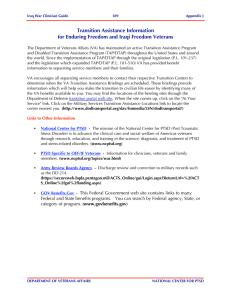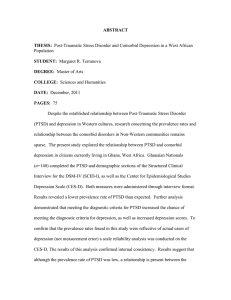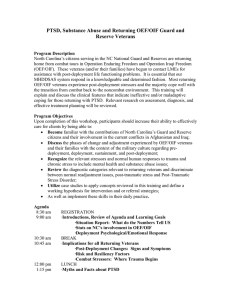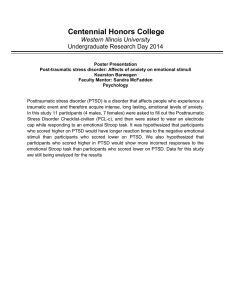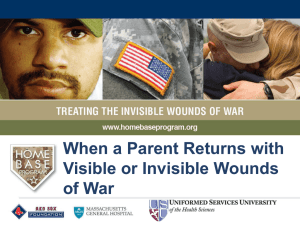TESTIMONY 6
advertisement
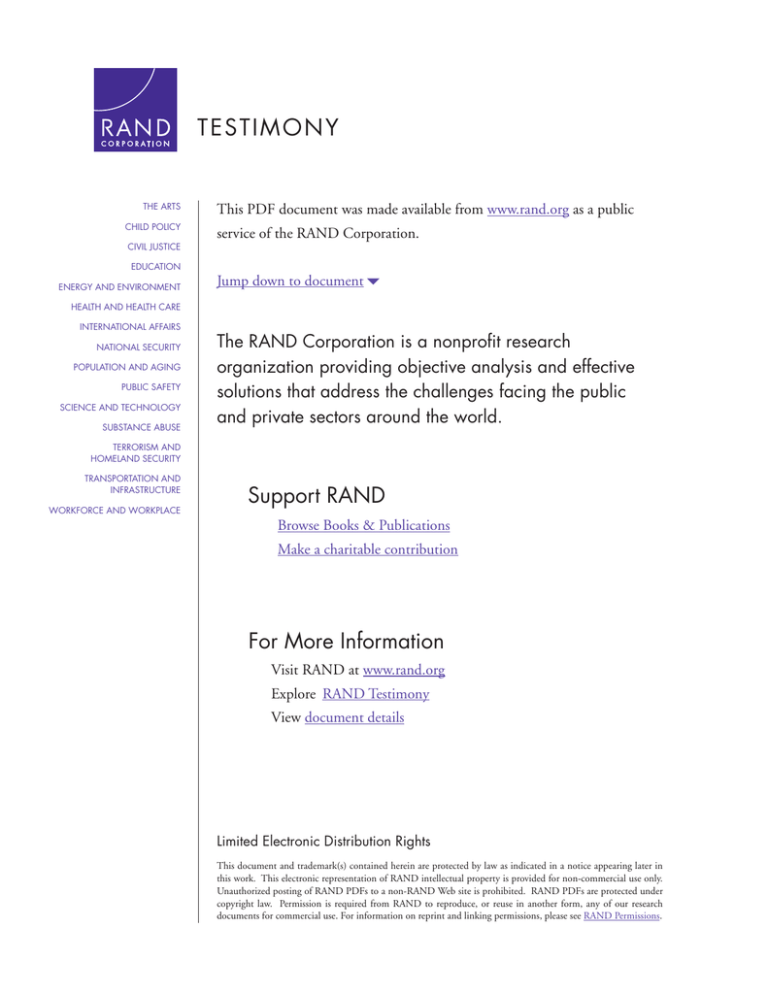
TESTIMONY THE ARTS CHILD POLICY CIVIL JUSTICE EDUCATION ENERGY AND ENVIRONMENT This PDF document was made available from www.rand.org as a public service of the RAND Corporation. Jump down to document6 HEALTH AND HEALTH CARE INTERNATIONAL AFFAIRS NATIONAL SECURITY POPULATION AND AGING PUBLIC SAFETY SCIENCE AND TECHNOLOGY SUBSTANCE ABUSE The RAND Corporation is a nonprofit research organization providing objective analysis and effective solutions that address the challenges facing the public and private sectors around the world. TERRORISM AND HOMELAND SECURITY TRANSPORTATION AND INFRASTRUCTURE WORKFORCE AND WORKPLACE Support RAND Browse Books & Publications Make a charitable contribution For More Information Visit RAND at www.rand.org Explore RAND Testimony View document details Limited Electronic Distribution Rights This document and trademark(s) contained herein are protected by law as indicated in a notice appearing later in this work. This electronic representation of RAND intellectual property is provided for non-commercial use only. Unauthorized posting of RAND PDFs to a non-RAND Web site is prohibited. RAND PDFs are protected under copyright law. Permission is required from RAND to reproduce, or reuse in another form, any of our research documents for commercial use. For information on reprint and linking permissions, please see RAND Permissions. TESTIMONY Assessing Combat Exposure and PostTraumatic Stress Disorder in Troops and Estimating the Costs to Society Implications from the RAND Invisible Wounds of War Study TERRI TANIELIAN This product is part of the RAND Corporation testimony series. RAND testimonies record testimony presented by RAND associates to federal, state, or local legislative committees; government-appointed commissions and panels; and private review and oversight bodies. The RAND Corporation is a nonprofit research organization providing objective analysis and effective solutions that address the challenges facing the public and private sectors around the world. RAND’s publications do not necessarily reflect the opinions of its research clients and sponsors. is a registered trademark. CT-321 March 2009 Testimony presented before the House Veterans’ Affairs Committee, Subcommittee on Disability Assistance and Memorial Affairs on March 24, 2009 Published 2009 by the RAND Corporation 1776 Main Street, P.O. Box 2138, Santa Monica, CA 90407-2138 1200 South Hayes Street, Arlington, VA 22202-5050 4570 Fifth Avenue, Suite 600, Pittsburgh, PA 15213-2665 RAND URL: http://www.rand.org To order RAND documents or to obtain additional information, contact Distribution Services: Telephone: (310) 451-7002; Fax: (310) 451-6915; Email: order@rand.org Terri Tanielian1 Study Co-Director, Invisible Wounds of War Study Team The RAND Corporation Assessing Combat Exposure and Post-Traumatic Stress Disorder in Troops and Estimating the Costs to Society Implications from the RAND Invisible Wounds of War Study2 Before the Committee on Veterans’ Affairs Subcommittee on Disability Assistance and Memorial Affairs United States House of Representatives March 24, 2009 Chairman Hall, Representative Lamborn, and distinguished members of the Subcommittee, thank you for inviting me to testify today. It is an honor and pleasure to be here. I will discuss the findings from our study “Invisible Wounds of War” as they relate to the topic of your hearing today. More specifically, my testimony will briefly review the findings from our study related to assessing exposure to combat and prevalence of post-traumatic stress disorder and depression among servicemembers returning from Operations Enduring Freedom and Iraqi Freedom; as well as the societal costs associated with these conditions. The full findings and recommendations from our study were also presented in the testimony to the full House Committee on Veterans Affairs on June 11, 2009. Background Since October 2001, approximately 1.7 million U.S. troops have deployed as part of Operation Enduring Freedom (OEF; Afghanistan) and Operation Iraqi Freedom (OIF; Iraq). The pace of the deployments in these current conflicts is unprecedented in the history of the all-volunteer force (Belasco, 2007; Bruner, 2006). Not only are a higher proportion of the armed forces being deployed, but deployments have been longer, redeployment to combat has been common, and breaks between deployments have been infrequent (Hosek, Kavanagh, and Miller, 2006). At the same time, episodes of intense combat notwithstanding, these operations have employed smaller forces and have produced casualty rates of killed or wounded that are historically lower than in earlier prolonged wars, such as Vietnam and Korea. Advances in both medical technology and body armor mean that more servicemembers are surviving experiences that would have led to 1 The opinions and conclusions expressed in this testimony are the author’s alone and should not be interpreted as representing those of RAND or any of the sponsors of its research. This product is part of the RAND Corporation testimony series. RAND testimonies record testimony presented by RAND associates to federal, state, or local legislative committees; government-appointed commissions and panels; and private review and oversight bodies. The RAND Corporation is a nonprofit research organization providing objective analysis and effective solutions that address the challenges facing the public and private sectors around the world. RAND’s publications do not necessarily reflect the opinions of its research clients and sponsors. 2 This testimony is available for free download at http://www.rand.org/pubs/testimonies/CT321/. 1 death in prior wars (Regan, 2004; Warden, 2006). However, casualties of a different kind have emerged in large numbers—invisible wounds, such as post traumatic stress disorder. As with safeguarding physical health, safeguarding mental health is an integral component of the United States’ national responsibilities to recruit, prepare, and sustain a military force and to address service-connected injuries and disabilities. But safeguarding mental health is also critical for compensating and honoring those who have served our nation. In April 2008, my colleagues and I released the findings from a one-year project entitled “Invisible Wounds of War. This independent study focused on three major conditions—post-traumatic stress disorder (PTSD), major depressive disorder, and traumatic brain injury (TBI). Unlike the physical wounds of war that maim or disfigure, these conditions remain invisible to other servicemembers, to family members, and to society in general. All three conditions affect mood, thoughts, and behavior; yet these wounds often go unrecognized and unacknowledged. Our study was guided by a series of overarching questions about the prevalence of mental health conditions, costs associated with these conditions, and the care system available to meet the needs of servicemembers afflicted with these conditions. In my comments today, I will focus on our findings about servicemembers’ exposure to trauma during deployment, prevalence of mental health conditions post deployment among OEF/OIF veterans, and the costs to society associated with these conditions among veterans, as they bear directly on the issue you are considering today. Specifically, I will address several related questions: Deployment Related Experiences and Exposure to Trauma: How is exposure to combat trauma assessed among OEF/OIF troops in research studies? Prevalence of PTSD and Depression: What is the scope of mental health conditions that troops experience when returning from deployment to Afghanistan and Iraq? Societal Costs of PTSD and Depression Among Veterans: What are the costs of these conditions, including treatment costs and costs stemming from lost productivity and other consequences? What are the costs and potential savings associated with different levels of medical care—including proven, evidence-based care; usual care; and no care? How is exposure to combat trauma assessed among OEF/OIF troops in research studies? In research studies, combat experience has been assessed using a variety of different means, including documenting deployment to a combat zone based on receipt of hostile-fire pay or 2 assessing specific experiences during deployment based on self-report. Most of the prior research has evaluated the relationship between these exposures and the development of postcombat adjustment difficulties such as post-traumatic stress disorder. Scholarly interest in exposure to combat-related traumas emerged following the official designation of PTSD as a psychiatric disorder by the American Psychiatric Association in 1980 (APA, 1980). The PTSD diagnosis replaced earlier terms such as “battle fatigue” and “war neurosis.” Among other changes, the PTSD diagnosis required a “catastrophic stressor that was outside the range of usual human experience”, and this requirement spurred the need to assess such experiences. The definition of what constitutes a trauma has changed over time, but the requirement that PTSD be linked to specific experiences remains. Researchers studying veteran populations since that time have used different scales to assess (using mainly self-report) specific details about a variety of exposures that military personnel may experience when deployed to a war zone. In our study, combat trauma exposure was assessed using 24 questions that were adapted from Hoge et al. (2004) and includes both direct and vicarious trauma exposure (e.g., witnessing a traumatic event that occurred to others). However, we found that many questions were empirically redundant with one another, and thus used only a subset of exposures (11 questions) to form a combat exposure measure that formed two indices: (1) a one-question measure that assessed whether the servicemember had ever experienced an injury or wound that required hospitalization while deployed (this may or may not have required medical evacuation from theater), and (2) a scale derived by counting the number of ten specific trauma exposures that occurred during any of the servicemember’s OEF/OIF deployments. Rates of reported trauma exposures on these11 items are presented in Table 1. As shown, rates of exposure to specific types of combat trauma ranged from 5 to 50 percent, with high reporting levels for many traumatic events. Vicariously experienced traumas (e.g., having a friend who was seriously wounded or killed) were the most frequently reported. About 10-15% of OEF/OIF veterans reported NO trauma exposures, and about 15-20 percent reported exposure to just ONE event (largely death or injury of a friend), so most (close to 75 percent) reported multiple exposures. 3 Table 1: Rates of Trauma Exposure in OEF/OIF (N=1965) Having a friend who was seriously wounded or killed Seeing dead or seriously injured non-combatants Witnessing an accident resulting in serious injury or death Smelling decomposing bodies Being physically moved or knocked over by an explosion Being injured, not requiring hospitalization Having a blow to the head from any accident or injury Being injured, requiring hospitalization Engaging in hand-to-hand combat Witnessing brutality towards detainees/prisoners Being responsible for the death of a civilian Weighted Percentage 49.6 45.2 45.0 37.0 22.9 22.8 18.1 10.7 9.5 5.3 5.2 95% CI LL 45.7 41.3 41.1 33.3 19.6 19.2 15.1 8.2 7.3 3.3 3.0 95% CI UL 53.6 49.1 48.9 40.7 26.1 26.3 21.1 13.1 11.6 7.3 7.4 Source: Schell and Marshall, 2008, in Tanielian and Jaycox (eds). Invisible Wounds of War: Psychological and Cognitive Injuries, Their Consequences, and Services to Assist Recovery. RAND Corporation, MG-720CCF. Note: CI = Confidence Interval; LL = Lower Limit; UL = Upper Limit. Percentages are weighted to reflect the full population of 1.64 million servicemembers who had deployed to OEF/OIF as of October 31, 2007. What is the scope of mental health issues faced by OEF/OIF troops returning from deployment? Most of the military servicemembers who have deployed to date in support of OIF or OEF will return home from war without problems and readjust successfully, but many have already returned or will return with significant mental health conditions. Among OEF/OIF veterans, our study found rates of PTSD and major depression to be relatively high, particularly when compared with the general U.S. civilian population. In late fall 2007, we conducted a telephone study of 1,965 previously deployed individuals sampled from 24 geographic areas. Using wellaccepted screening tools for conducting epidemiological studies, we estimated substantial rates of mental health problems in the past 30 days among OEF/OIF veterans, with 14 percent reporting current symptoms consistent with a diagnosis of PTSD and 14 percent reporting symptoms consistent with a diagnosis of major depression (9 percent of veterans reported symptoms consistent with a diagnosis of both PTSD and major depression). Major depression is often not considered a combat-related injury; however, our analyses suggest that it is highly associated with combat exposure and should be considered in the spectrum of post-deployment mental health consequences. Assuming that the prevalence found in this study is representative of the 1.64 million servicemembers who had been deployed for OEF/OIF as of October 2007, we estimate that as of April 2008 approximately 303,000 OEF/OIF veterans were suffering from PTSD or major 4 depression. We also found that some specific groups, previously underrepresented in studies— including the Reserve Components and those who have left military service—may be at higher risk of suffering from these conditions. But the single best predictor of reporting current mental health problems consistent with a diagnosis of PTSD or depression was the number of combat traumas reported while deployed. It is important to note that these data were cross-sectional in nature, that is, they provide a snapshot of the scope of mental health need among OEF/OIF veterans. These estimates may change as more individuals return from deployments or more individuals begin to suffer post-combat related difficulties that rise to a level of meeting diagnostic criteria. Seeking and Receiving Treatment. Military servicemembers with probable PTSD or major depression seek care at about the same rate as the civilian population, and, just as in the civilian population, many of the afflicted individuals were not receiving treatment. About half (53 percent) of those who met the criteria for current PTSD or major depression had sought help from a physician or mental health provider for a mental health problem in the past year. Even when individuals receive care for their mental health condition, too few receive quality care. Of those who have a mental disorder and also sought medical care for that problem, just over half received a minimally adequate treatment. The number who received quality care (i.e., a treatment that has been demonstrated to be effective) would be expected to be even smaller. Focused efforts are needed to significantly improve both accessibility to care and quality of care for these groups. The prevalence of PTSD and major depression will likely remain high unless greater efforts are made to enhance systems of care for these individuals. Survey respondents identified many barriers to getting treatment for their mental health problems. In general, respondents were concerned that treatment would not be kept confidential and would constrain future job assignments and militarycareer advancement. About 45 percent were concerned that drug therapies for mental health problems may have unpleasant side effects, and about one-quarter thought that even good mental health care was not very effective. These barriers suggest the need for increased access to confidential, evidence-based psychotherapy, to maintain high levels of readiness and functioning among previously deployed servicemembers and veterans. What are the costs of these mental health and cognitive conditions to the individual and to society? The costs of these invisible wounds go beyond the immediate costs of mental health treatment. Adverse consequences that may arise from post-deployment mental and cognitive impairments include suicide, reduced physical health, increased engagement in unhealthy behaviors, substance abuse, unemployment, poor performance while at work, homelessness, marital strain, 5 domestic violence, and poor parent-child relationships. The costs stemming from these consequences are substantial, and may include costs related to lost productivity, reduced quality of life, substance abuse treatment, and premature mortality. To quantify these costs, RAND undertook an extensive review of the literature on the costs and consequences of post-traumatic stress disorder (PTSD) and depression. Our analysis included the development and use of a micro-simulation model to estimate two-year post-deployment costs associated with PTSD and depression for military servicemembers returning from OEF and OIF. Our analyses use a societal cost perspective, which considers costs that accrue to all members of U.S. society including government agencies (e.g., DoD and VA), servicemembers, their families, employers, private health insurers, taxpayers, and others. In conducting the microsimulation analysis for PTSD and depression, we also estimated the costs and potential savings associated with different levels of medical care, including proven, evidence-based care, usual care, and no care. We found that unless treated, PTSD and depression have wide-ranging and negative implications for those afflicted and exact a high economic toll to society. The presence of any one of these conditions can impair future health, work productivity, and family and social relationships. Individuals afflicted with any of these conditions are more likely to have other psychiatric diagnoses (e.g., substance use) and are at increased risk for attempting suicide. They have higher rates of unhealthy behaviors (e.g., smoking, overeating, unsafe sex) and higher rates of physical health problems and mortality. Individuals with any of these conditions also tend to miss more days of work or report being less productive. There is also a possible connection between having one of these conditions and being homeless. Suffering from these conditions can also impair relationships, disrupt marriages, aggravate the difficulties of parenting, and cause problems in children that may extend the consequences of combat experiences across generations. Below, we summarize some of the key negative outcomes that have been linked to PTSD and depression in prior studies. For a more thorough discussion of these issues, please see Tanielian and Jaycox [Eds.], 2008, Chapter Five. Suicide: Depression and PTSD both increase the risk for suicide, as shown by evidence from studies of both military and civilian populations. Psychological autopsy studies of civilian suicides have consistently shown that a large number of civilians who committed suicide had a probable depressive disorder. One study showed that approximately 30 percent of veterans committing suicide within 1-year had a mental health disorder such as depression, as did approximately 40 percent of veterans attempting suicide. Although not as strongly associated with suicide as 6 depression, PTSD is more strongly associated with suicidal thoughts and attempts than any other anxiety disorder and has also been linked to elevated rates of suicide among Vietnam veterans. Physical Health: Depression and PTSD have been linked to increased morbidity. With respect to physical health, cardiovascular diseases are the most frequently studied morbidity outcome among persons with psychiatric disorders. Both PTSD and depression have been linked to higher rates of heart disease in military and civilian populations. Depression also affects conditions associated with aging, including osteoporosis, arthritis, Type 2 diabetes, certain cancers, periodontal disease, and frailty. Health-compromising Behaviors: The link between depression and PTSD and negative physical health outcomes may be partly explained by increases in health-risk behaviors that influence health outcomes. For example, research on civilian populations has shown a clear link between PTSD and depression and smoking, as well as a link between symptoms of depression and PTSD and sexual risk taking. Substance Abuse: Rates of co-occurring substance use disorders with PTSD and depression, are common and are often associated with more-severe diagnostic symptoms and poorer treatment outcomes. Several studies have examined the relationship between mental disorders and alcohol and drug abuse. The results have varied, depending on the specific condition studied. Studies of Vietnam veterans showed that PTSD increases the risk of alcohol and substance abuse, while other studies of civilian populations have found that depression tends to be a consequence of substance abuse rather than a cause. Labor Market Outcomes: PTSD and depression influence labor-market outcomes as well. Specifically, there is compelling evidence indicating that these conditions will affect servicemembers’ return to employment, their productivity at work, and their future job prospects. Studies of Vietnam veterans have also found that those with a diagnosis of depression or PTSD had lower hourly wages than Vietnam veterans without a diagnosis. Homelessness: Few studies have examined the rates of homelessness among individuals with PTSD or, depression; rather, most studies have studied the prevalence of mental disorders among homeless individuals. Compared with non-homeless persons in the general population, homeless people have higher rates of mental disorder and are more likely to experience a severe mental disorder. One study found that 75 percent of homeless individuals with PTSD had developed the condition prior to becoming homeless. However, evidence in this area is not strong, 7 and the prevalence of mental disorders among homeless people may be overstated, possibly the consequence of studies relying on poor sampling methods or flawed assumptions. Marriage and Intimate Relationships: The effects of post-combat mental and cognitive conditions inevitably extend beyond the afflicted servicemember. As servicemembers go through life, their impairments cannot fail to wear on those with whom they interact, and those closest to the servicemember are likely to be the most severely affected. Studies of Vietnam veterans, whose results parallel those among civilian populations, have linked PTSD and depression to difficulties maintaining intimate relationships, and these deficits account for a greatly increased risk of distressed relationships, intimate-partner violence, and divorce among those afflicted. Child Outcomes: In addition, the interpersonal deficits that interfere with emotional intimacy in the romantic relationships of servicemembers with these PTSD and depression may interfere with their interactions with their children. In particular, interviews with spouses of veterans from several conflicts (World War II, Korea, and Vietnam) have all revealed a higher rate of problems among children of veterans with symptoms of PTSD. Rates of academic problems, as well as rates of psychiatric treatment, were also higher in children of veterans with PTSD compared to children of veterans without PTSD. The implications of a parent’s depression on children’s outcomes has not been studied directly in military populations, but numerous studies of civilian populations have shown that the children of depressed parents are at far greater risk of behavioral problems and psychiatric diagnoses than children of non-depressed parents. A limitation of the research summarized above is that virtually none of the studies we reviewed were randomized controlled trials, and thus may not be able to detect causal relationships between these disorders and subsequent adverse consequences such as homelessness, substance abuse, or relationship problems. Further, the majority of studies reviewed drew from data on Vietnam-era veterans or from data on civilians. Nevertheless, these studies are important for understanding the range of co-morbidities and behavioral outcomes likely to be associated with PTSD and depression, and this information is relevant for determining the required resources for treating veterans with these conditions. Effective treatments for PTSD and depression exist (Tanielian and Jaycox [Eds.}, 2008, Chapter 7), and can greatly improve functioning. With adequate treatment and support, some veterans may avoid negative outcomes altogether. What are the associated economic costs to society? To understand the consequences of these conditions in economic terms, we developed a microsimulation model. Using data from the literature (which had limited information on specific 8 populations and costs), we estimated the costs associated with mental health conditions (PTSD and major depression) for a hypothetical cohort of military personnel deployed to Afghanistan and Iraq. We defined costs in terms of lost productivity, treatment, and suicide attempts and completions, and we estimated costs over a two-year period (see Tanielian and Jaycox [Eds.], 2008, Chapter Six). For this analysis, we focus specifically on the costs of PTSD and depression, and we considered the costs associated with different types of treatment and different patterns of comorbidity, allowing for remission and relapse rates to be influenced by treatment type. The data available to conduct this type of detailed analysis for specific mental health conditions, however, did not support projecting costs beyond a 2 year time horizon. For each condition, we generated two estimates—one that included the medical costs and the value of lives lost due to suicide, and one that excluded such costs. We were unable to estimate the costs associated with homelessness, domestic violence, family strain, and substance abuse because reliable data are not available to create credible dollar figures for these outcomes. If figures for these consequences were available, the costs of having these conditions would be higher. Our estimates represent costs incurred within the first two years after returning home from deployment, so they accrue at different times for different personnel. For service members who returned more than two years ago and have not redeployed, these costs have already been incurred. However, these calculations omit costs for servicemembers who may deploy in the future, and they do not include costs associated with chronic or recurring cases that linger beyond two years. (Details of our model assumptions and parameters can be found in Tanielian and Jaycox [Eds.], 2008, Chapter Six). Our microsimulation model predicts that two-year post-deployment costs to society resulting from PTSD and major depression for 1.64 million deployed servicemembers (as of October 2007) could range from $4.0 to $6.2 billion (in 2007 dollars), depending on how we account for the costs of lives lost to suicide. For PTSD, average costs per case over two years range from $5,904 to $10,298; for depression, costs range from $15,461 to $25,757; and for PTSD and major depression together, costs range from $12,427 to $16,884. The majority of the costs were due to lost productivity. Because these numbers do not account for future costs that may be incurred if additional personnel deploy and because they are limited to two years following deployment, they underestimate total future costs to society. Providing Evidence-Based Treatment for PTSD and Depression Can Reduce Societal Costs. Certain treatments have been shown to be effective for both PTSD and major depression, 9 but these evidence-based treatments are not yet available in all treatment settings. We estimate that evidence-based treatment for PTSD and major depression would pay for itself within two years, even without considering costs related to substance abuse, homelessness, family strain, and other indirect consequences of mental health conditions. Evidence-based care for PTSD and major depression could save as much as $1.7 billion, or $1,063 per returning veteran; the savings come from increases in productivity, as well as from reductions in the expected number of suicides. Given these numbers, investments in evidence-based treatment would make sense, not only because of higher remission and recovery rates but also because such treatment would increase the productivity of servicemembers. The benefits to increased productivity would outweigh the higher costs of providing evidence-based care. These benefits would likely be even higher had we been able to capture the full spectrum of costs associated with mental health conditions. However, a caveat is that we did not consider additional implementation and outreach costs (over and above the day-to-day costs of care) that might be incurred if DoD and the VA attempted to expand evidence-based treatment beyond current capacity. Summary Our study found high rates of exposures to combat trauma during deployment and revealed serious prevalence (18.5%) of current PTSD and depression among servicemembers who had returned from OEF or OIF. In our analyses (not presented in this testimony), we also found significant gaps in access to and the quality of care provided to this population. Too few of those with PTSD and depression were getting help, and among those that were getting help too few were getting even minimally adequate care. If left untreated or under-treated, these conditions can have negative cascading consequences and result in a high economic toll. Investing in evidence based care for all of those in need can reduce the costs to society in just two years. Ensuring all veterans afflicted with these conditions will require addressing the significant gaps that exist in access to and quality of care for our nation’s veterans. Thank you again for the opportunity to testify today and to share the results of our research. Additional information about our study findings and recommendations can be found at: http://veterans.rand.org. 10 References American Psychiatric Association, Diagnostic and Statistical Manual For Mental Disorders, Third Edition. Washington, DC. American Psychiatric Association, 1980. Belasco, A. The Cost of Iraq, Afghanistan, and Other Global War on Terror Operations Since 9/11. Washington, D.C.: Congressional Research Service, 2007. Bruner, E. F. Military Forces: What Is the Appropriate Size for the United States? Washington, D.C.: Congressional Research Service, 2006. Hoge, C. W., C. A. Castro, S. C. Messer, D. McGurk, D. I. Cotting, and R. L. Koffman. Combat duty in Iraq and Afghanistan, mental health problems, and barriers to care. New England Journal of Medicine, Vol. 351, No. 1, July 2004, pp. 13–22. Hosek, J., J. Kavanagh, and L. Miller. How Deployments Affect Service Members. Santa Monica, Calif.: RAND Corporation, MG-432-RC, 2006. As of March 13, 2008: http://www.rand.org/pubs/monographs/MG432/. Institute of Medicine, Committee on Treatment of Post-traumatic Stress Disorder, Board on Population Health and Public Health Practice. Treatment of Post-traumatic Stress Disorder: An Assessment of the Evidence. Washington, D.C.: National Academies Press, 2007. Regan, T. Report: High survival rate for US troops wounded in Iraq. Christian Science Monitor, November 29, 2004. Tanielian T and Jaycox LH (Eds). Invisible Wounds of War: Psychological and Cognitive Injuries, Their Consequences and Services to Assist Recovery. Santa Monica, California. RAND Corporation MG 720-CCF, 2008. Warden, D. Military TBI during the Iraq and Afghanistan wars. Journal of Head Trauma Rehabilitation, Vol. 21, No. 5, 2006, pp. 398–402. 11

